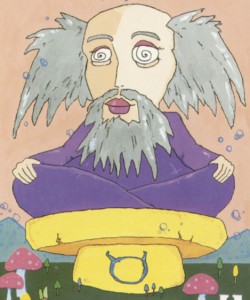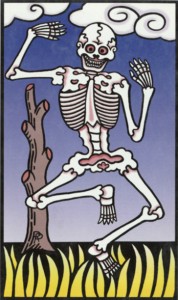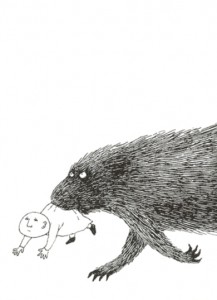Why Do We Meditate?
 In reading the transcript of Christina Feldman‘s talk on Dependent Co-Arising (for the DPP homework assignment), I was struck by her comments on the paradox of meditation, which is that we practice “being with what is,” but we do it in order to develop greater peace, clarity, compassion and wisdom. (Which sounds like we’re trying to find something better than what is.)
In reading the transcript of Christina Feldman‘s talk on Dependent Co-Arising (for the DPP homework assignment), I was struck by her comments on the paradox of meditation, which is that we practice “being with what is,” but we do it in order to develop greater peace, clarity, compassion and wisdom. (Which sounds like we’re trying to find something better than what is.)
Here’s what she says, “This is actually an interesting paradox because it straddles a very fine line. One part of meditation, for example, is the capacity to be in harmony with what is. At the same time, there’s a visionary part in every spiritual practice which is about what is possible. Holding these two together is the challenge of the practice; being with what is through our meditation training, we need to separate from any sense of resignation or passivity.
“Positively, being with what is means seeing the true nature of what’s happening in the moment — it is arising, it is passing, it has its own flavor, etc. On the other hand, knowing what is possible means giving attention to our own capacities for awareness and wisdom, and having the clarity to hold what is happening in the light of wisdom. That’s the visionary part.
“So it’s not about changing the world; it’s not about changing myself into a more enlightened self. It is about the sense of trusting the vision that freedom, clarity and very deep and powerful levels of understanding are possible, that they begin and are born in what is within the field of our experience right now.
“We don’t meditate in order to stay the same. We don’t meditate in order to reject whatever is present in the moment. We meditate in order to find the possibility in the moment, first through seeing the capacity for freedom within that moment.”
(image: Phantasmagoric Theater Tarot)
One Thing Leads to Another
 So what’s the point of all these links? Christina Feldman says that Dependent Co-Arising is “really the heart or the essence of all Buddhist teaching. What is described in the process is the way in which suffering can arise in our lives, and the way in which it can end…It describes a vision of life or an understanding in which we see the way everything is inter-connected — that there is nothing separate, nothing that stands alone, everything affects everything else.”
So what’s the point of all these links? Christina Feldman says that Dependent Co-Arising is “really the heart or the essence of all Buddhist teaching. What is described in the process is the way in which suffering can arise in our lives, and the way in which it can end…It describes a vision of life or an understanding in which we see the way everything is inter-connected — that there is nothing separate, nothing that stands alone, everything affects everything else.”
The Buddha described the basic principle of dependent co-arising as: When there is this, that is. With the arising of this, that arises. When this is not, neither is that. With the cessation of this, that ceases.
Christina Feldman says, “When one thing follows after another — one cycle of reaction, one cycle of response, once cycle of being locked into an opinion or a feeling or a mind-storm…when all of that is happening, there is a feeling of wandering, being pushed from one state to another, seemingly without choice, sometimes not knowing how we got there…
“This sense of wandering in confusion or blindly from one state of experience to another, one state of reaction to another, one state of contraction to another is called samsara…the movement from one state of perception and experience to another without knowing what’s going on…
“It is not unusual to have this experience…and to feel quite powerless because of the confusion present in that situation. Understanding how things come together, how they interact, actually removes that sense of powerlessness or that sense of being a victim of life or helplessness. Because if we understand how things come together, we can also begin to understand the way out, how to find another way of being, and realize that life is not random chaos.
“Another effect of understanding causes and conditions means accepting the possibility of change. And with acceptance comes another understanding that with wisdom, we have the capacity to create beneficial and wholesome conditions for beneficial and wholesome results.
“And that’s the path — an understanding that we have the capacity to make choices in our lives that lead toward happiness, that lead toward freedom and well-being rather than feeling that we’re just pushed by the power of confusion or by the power of our own misunderstanding. This understanding helps to ease the sense of separateness and isolation and it reduces delusion.”
(image: Phatansmagoric Theater Tarot)
Nothing Lasts Forever
 The last link in the chain of Dependent Co-Arising is jaramarana, usually translated as “aging and death.” That which arises, passes away. That which is born…dies.
The last link in the chain of Dependent Co-Arising is jaramarana, usually translated as “aging and death.” That which arises, passes away. That which is born…dies.
This is not meant to be morbid. Or depressing. It’s just the way it is. And not only for our physical being. When we identify strongly (take “birth” in) a particular state of being, we set ourselves up for the inevitable sense of loss that comes when things change.
So what to do?
Christina Feldman says, “What’s important to remember is that none of this is predetermined. Just like the climate for snow, the presence of certain of these links is going to allow other experiences to happen. Not that they must happen, or definitely will happen, but they allow for certain experiences to happen.”
She describes the Third Noble Truth (that there is an end to suffering) as a “portrayal of the way in which it is possible to step off a sense of being bound to this wheel of samsara or to the links of dependent origination. It is significant to remember that it doesn’t have to be any one link that we step off of, or that there is only one place where we can get out of the maze. In fact, we can step out of the maze and into something else at any one of these links.”
Jaramarana is also translated as “aging and dying, grief, sorrow, suffering, lamentation and despair.” Whew. For the DPP homework, I think I’m going to keep it simple: “death.”
(image: Buddha Tarot)
Here I Am
 The next link on the chain of Dependent Co-Arising is jati, which translates as “birth.” This is the “moment of arrival,” the sense of “I’ve got it!” or “this is who I am.”
The next link on the chain of Dependent Co-Arising is jati, which translates as “birth.” This is the “moment of arrival,” the sense of “I’ve got it!” or “this is who I am.”
Christina Feldman says that this is the moment of “emergence of an identity, a sense of self that rests upon identifying with a state of experience or mode of conduct…the do-er, the thinker, the seer, the knower, the experiencer…..the sufferer.”
Suffering is, of course, what eventually happens. Because being someone or something always comes with the stress of defending that state, with trying to keep it going, or controlling it in some way. Which can not be sustained.
That which arises, passes away.
This leads us to the next link of the chain (coming tomorrow).
Stay tuned.
(image: detail from illustration by Edward Gorey)
Drum Roll, Please
 The next link in the chain of Dependent Co-Arising is bhava, usually translated as “becoming.” When we cling to the idea that something….or someone….can make us happy (or unhappy), or that our views/opinions/beliefs are RIGHT (and therefore need to be defended), or we when hold onto some idea about who we are and the way things SHOULD be — then we have started to become that belief.
The next link in the chain of Dependent Co-Arising is bhava, usually translated as “becoming.” When we cling to the idea that something….or someone….can make us happy (or unhappy), or that our views/opinions/beliefs are RIGHT (and therefore need to be defended), or we when hold onto some idea about who we are and the way things SHOULD be — then we have started to become that belief.
Here’s what Christina Feldman says, “Clinging is followed by becoming — the entire process of fixing or positioning the sense of self in a particular state of experience. Any time we think in self-referential terms…’I am angry,’ ‘I am loving,’ ‘I am greedy,’ etc….an entire complex of behavior is generated to serve craving and clinging. I see something over there that I’ve projected as the thing ‘that is going to make me really happy if I get it,’ and then I organize my behavior, my actions and my attention in order to find union with that. This is the process of becoming — becoming someone or something other that what is.”
Bhava is also translated as “being,” or “arising,” but I’ve gotten used to “becoming” as the standard translation, so for the DPP homework, I’m sticking with that.
(image: this is one of those old cards I’ve had in my collection for years. I don’t know who to credit.)
But I NEED It!
 The next link in the chain of Dependent Co-Arising is upadana, usually translated as “clinging.” The previous link, “craving,” has a directional momentum to it, and when that impulse to move becomes intense (which it almost always seems to do), craving turns into “clinging.”
The next link in the chain of Dependent Co-Arising is upadana, usually translated as “clinging.” The previous link, “craving,” has a directional momentum to it, and when that impulse to move becomes intense (which it almost always seems to do), craving turns into “clinging.”
Clinging to sensuality or sense objects is one of the ways we create suffering for ourselves. Christina Feldman says, “Pleasant feelings, rather than satisfying us and making us feel this way or that, often produce a desire for more as well as a desire to hold on, which in turn creates more clinging.”
But the feeling that this is something I need is pretty convincing.
Christina goes on to say, “I think there’s an easy way to distingue between craving and valid need, and this is that one can be satisfied and the other can’t. If you’re very hungry and you eat, it’s enough, right? The hunger is gone and you move on. If it’s an insatiable hunger, say, or addition to food, that’s never satisfied.
“If you have a valid need to eat, sleep, to be sheltered…your pathway is often very clear. It’s not complicated. But that doesn’t seem to be true of craving. There’s a kind of floundering, obsessiveness, busy-ness around it. It’s not so simple.”
Upadana is also translated as “grasping,” or “attachment.” But I like the literation of “craving” and “clinging,” so for the DPP homework, I’ll stick with “clinging.”
(image: Tarot of the Witches)
THIS Will Make Me Happy
 The next link in the chain of Dependent Co-Arising is tanha, usually translated as “craving.” This is the point where “Ah, this is pleasant,” turns into “I want more!” (Or “Yuck, this is unpleasant,” turns into “Get that away from me!” Or “Hmmm, this isn’t pleasant or unpleasant,” turns into “BORING!”)
The next link in the chain of Dependent Co-Arising is tanha, usually translated as “craving.” This is the point where “Ah, this is pleasant,” turns into “I want more!” (Or “Yuck, this is unpleasant,” turns into “Get that away from me!” Or “Hmmm, this isn’t pleasant or unpleasant,” turns into “BORING!”)
Christina Feldman says, “It is at the point where craving arises in response to pleasant or unpleasant feeling that our responses become very complex. And it’s also a place where we run into a world of struggle. The important thing to remember is that craving is also a kind of moment-to-moment experience; it arises and it passes.
“Within our condition it becomes the foundation of developing specific attitudes and values…So we say, ‘This has the power to make me happy.’ Or ‘This has the power to make me unhappy. If I get this thing or I get this meal or I get this experience, then I’m going to be happy. If I don’t get it, or if I get something that I don’t want, then of course I’m going to be unhappy.’
“So what happens through craving is that in a way we delegate authority to an object or to an experience or to a person. And of course, in delegating authority or power to that separated entity, something else is happening at the same time, namely that we are depriving ourselves of authority. As a result, our sense of well being, our sense of contentment or freedom comes to be dependent upon what we get or don’t get; or our success in being able to get or to get rid of that element…
“And yet this never ends because the promise is never fulfilled. As you know from your own experience, we get the thing we thought we always needed to make us happy, and then we lose interest in it, or get bored. So in a way there’s a kind of anxiety generated through ignorance and through the sense of separation which can never be satisfied…
“You all know that kind of restlessness of appetite–there’s never enough; just one more thing is needed; one more experience, one more mind state, one more object, one more emotion, and then I’ll be happy….Here we are dealing with a basic, never-ending hunger.”
Tanha is sometimes translated as “emotional urge,” “desire,” or “unquenchable thirst.” I like “unquenchable,” but for the homework assignment, I’m going with simple “craving.”
(image: Housewives Tarot)
Ouch.
 The next link in the chain of Dependent Origination/Co-Arising is vedana, which is almost always translated as “feeling” or “feeling tone.” This is not “feeling” in the way we “feel” our emotions. It’s in the way we “feel” the impact of a sensation as it comes into contact with awareness.
The next link in the chain of Dependent Origination/Co-Arising is vedana, which is almost always translated as “feeling” or “feeling tone.” This is not “feeling” in the way we “feel” our emotions. It’s in the way we “feel” the impact of a sensation as it comes into contact with awareness.
Vedana is a simple, feeling response to contact (phassa), and it is always either pleasant, unpleasant or neutral. (“Neutral” is more accurately “neither-pleasent-nor-unpleasant.”)
The image I chose here looks like the feeling tone is always unpleasant, but that’s because I want to keep in mind that even pleasant sensations….the taste of really good dark chocolate, for example, or a beautiful sunset, or the touch of a baby’s skin….even these lovely sensations have the potential for pain, if we cling to them and keep wanting more. Neutral sensations also have this potential, because we tend to space out when they’re present and not notice what’s going on.
Christina Feldman says, “It is important to acknowledge that the links of contact, of sense doors and feeling that we are talking about are neither wholesome nor unwholesome in and of themselves, but become the catalyst for what happens next. The sense doors, the feelings and the contact are the forerunners of complexity. They are the forerunners of how we actually react or respond, and how we begin to weave a personal story out of events or impressions that all of us experience at all times.
“Therefore contact, feeling and sense doors are pretty important places to pay attention to. Because it’s when we move on to the next link of craving that we begin to see more precisely the process of suffering and complexity that begins to emerge.”
Vedana can also be translated as “sensation,” but for the DPP assignment, I’m going with “feeling tone.”
(image: Napo Tarot)
Bingo!
 The next link in the chain of Dependent Origination (also called Dependent Co-Arising) is phassa, most often translated as “contact.”
The next link in the chain of Dependent Origination (also called Dependent Co-Arising) is phassa, most often translated as “contact.”
This is the point when a sensation from the eyes, ears, nose, tongue, skin…or thoughts, ideas, images, etc. from the mind….come into contact with awareness.
Christina Feldman says, “Contact is the meeting between the sense door and the sense information–I ring the bell, hearing arises. You have an itch in your body, your body consciousness arises. You smell something cooking in the kitchen, the smell sense door arises. This arising always involves the coming together of the sense door, the sense object and consciousness. Those three elements together is what contact is.
“The Buddha once said that with contact the world arises. And with cessation of contact there is the cessation of the world. It doesn’t mean wipe-out. What it means is that there’s a cessation of the world that is perceived according to sankharas (habitual patterns of thinking, feeling, etc.) and ignorance. There’s cessation of a ‘personal’ perception of the world.
“Each moment of contact is the isolating of an impression out of the whole stream and presence of impressions that are present for us in every moment. There’s a vast number of impressions/phenomena going on. Contact is what happens when something jumps out of that background and becomes foreground. We’re paying attention to it. There’s that meeting of the sense object, the sense door, and consciousness. The sensation stands out for us. That is contact.”
Phassa is sometimes translated as “sensory impingement” or “sense experience.” But I like the immediacy of “contact,” so for the DPP homework, I’m going with that.
(image: illustration by George Willett from “Creative Whack Pack.”)
What Comes Through the Door
 Christina Feldman says: “In classical presentations, the process of Dependent Origination is comprised of twelve links. It is important to understand that this in not a linear, progressive, or sequential presentation. It’s a process always in motion and not static at all. It’s also not deterministic. I don’t think that one link determines the arising of the next link. But rather that the presence of certain factors or certain of these links together provide the conditions in which the other links can manifest…It’s a bit like a snowstorm–the coming together of a certain temperature, a certain amount of precipitation, a certain amount of wind…co-creating a snow storm.”
Christina Feldman says: “In classical presentations, the process of Dependent Origination is comprised of twelve links. It is important to understand that this in not a linear, progressive, or sequential presentation. It’s a process always in motion and not static at all. It’s also not deterministic. I don’t think that one link determines the arising of the next link. But rather that the presence of certain factors or certain of these links together provide the conditions in which the other links can manifest…It’s a bit like a snowstorm–the coming together of a certain temperature, a certain amount of precipitation, a certain amount of wind…co-creating a snow storm.”
That said, the next “link” in this chain of conditions is called salayatana, which translates as “the six sense bases” or “fields of sense experience.” In Buddhist terms, these six are the five physical senses (sight, sound, taste, touch and smell) plus the mental “sense” of mind, which includes thoughts, memories, images, ideas, etc. Metaphorically, these sense organs are considered “doors” through which sense impressions (sights, sounds, tastes….as well as thoughts and ideas) come into awareness. So just as the eye is the receptor for sight sensations, mind is the receptor for thought sensations.
Sense “bases” doesn’t have a lot of meaning for me. I like the idea of doors opening up to let sensations come into awareness, so for the homework assignment, I’m going with “sense doors.”
(image: Q-Cards by Zolo Inc.)
